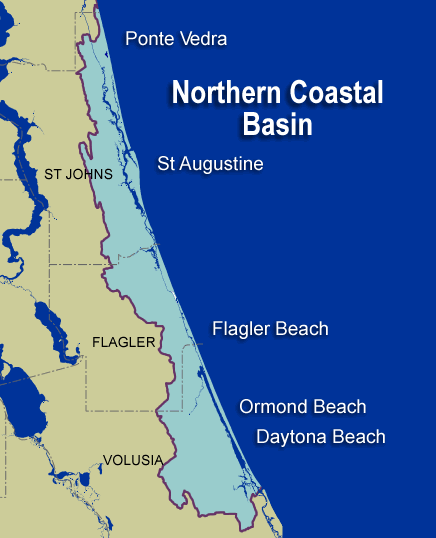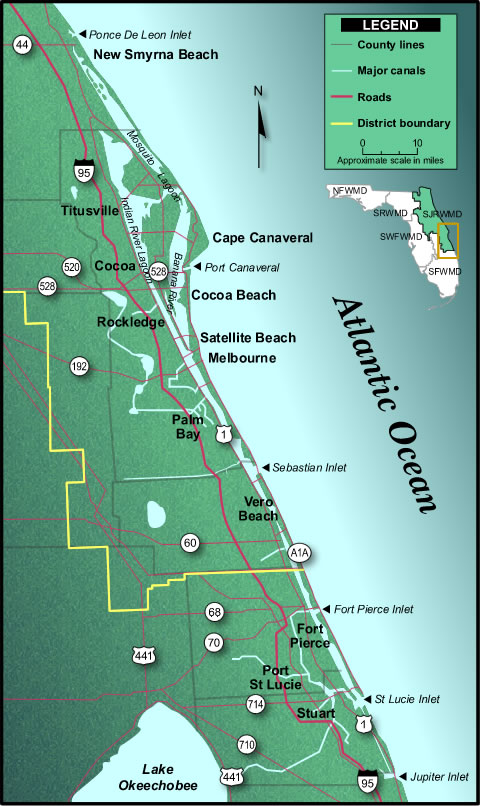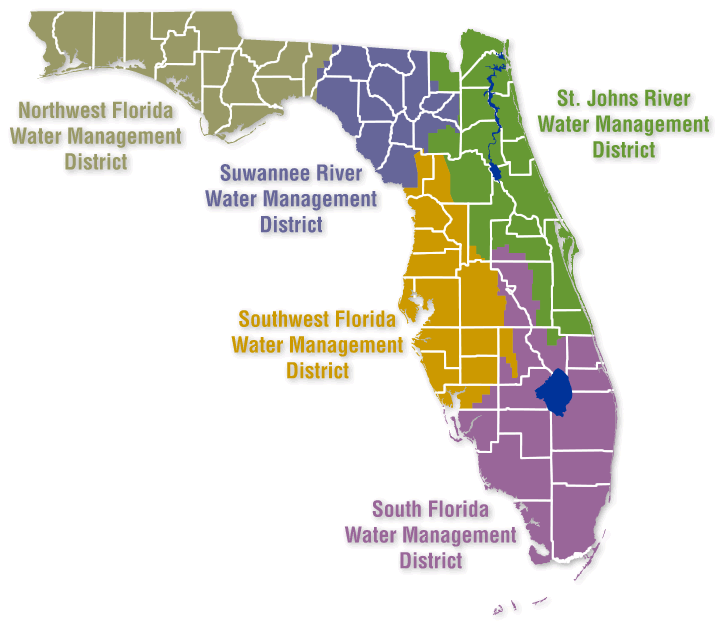1999
The Florida Forever Act provided $300 million per year for 10 years for land acquisition, water resource protection and supply, ecosystem restoration, and urban parks and open space. The act replaced the expired Preservation 2000 program.
1998
The Watershed Action Volunteer (WAV) Program expanded into Nassau and Lake counties. The program’s area of focus shifted from solely the St. Johns River’s watershed to seven, separate countywide programs. In addition to measuring water quality, the program’s volunteers educated the public about the watershed they lived in, focusing on neighborhood stormwater ponds and ways to prevent negative environmental impacts from stormwater runoff.
1998
Nineteen water segments in the Middle St. Johns River Basin were listed by DEP as 303(d). The designation refers to section 303(d) of the 1972 Clean Water Act and means that the areas do not have sufficient water quality to meet their stated beneficial uses — such as drinking or recreational use.
1998
The Solid Waste Management Trust Fund Review Commission recommended $25 million be provided annually for the SWIM program.
June-July 1998
Wildfires swept across more than 450,000 acres in Florida. Eighty-five percent of the fires burned within the 19 counties that made up the St. Johns River Water Management District. In the end, 10 percent of all the lands burned that summer were on district-owned public lands.
Dec. 10, 1997
The St. Johns River Water Management District joined individuals, businesses, government and the environmental community for a Lower St. Johns River Basin Strategic Planning Session, or River Summit. Participants pledged to restore and enhance the river’s lower basin, outlining a five-year plan in the “River Agenda.”
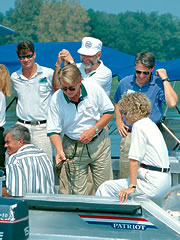
Jacksonville Mayor John Delaney looks at a sample of tape grass taken from the St. Johns River during a tour he took in the summer of 1997 in which he learned about the environmental damage to the river. At right is District Governing Board member Kathy Chinoy. After getting a first-hand look at challenges facing the river, Delaney held a summit in Jacksonville to plan for the revitalization of the river.
1997
Approximately 38 percent of flow from Florida’s domestic wastewater treatment plants was reused.
1997
The Florida Legislature defines regional water supply planning responsibilities of the five water management districts, local governments and utilities, leading the St. Johns River Water Management District to start its water resource development program and water supply development assistance program.
1996-1997
The St. Johns River Water Management District received $91 million in state and federal funds to purchase land for restoration of wetlands on former muck farms around Lake Apopka. “That funding will carry us far in our work to restore what was once the best fishing waters in the Southeast,” said Bill Segal, chairman of the district’s Governing Board.
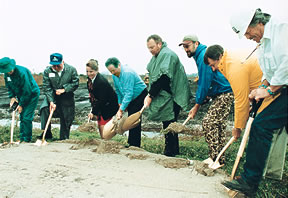
Various dignitaries participated in a ceremony — undaunted by rainy skies — to mark the beginning of the Lake Apopka restoration with a dirt-turning ceremony at the lake.
1996
St. Johns River Water Management District land ownership surpassed 400,000 acres.
July 1996
The St. Johns River Water Management District’s website went on‑line.
1996
“Partnerships with other government agencies and the public became a primary theme in 1996 that helped the St. Johns River Water Management District make great strides in its work to restore and protect our water resources,” said Bill Segal, chairman of the district’s Governing Board, in the district’s Annual Report. “When we’re able to combine our funding and other technical expertise with other public agencies, private property owners and the general public, we all benefit.”
1996
The Florida Legislature established an Ecosystem Management and Restoration Trust Fund and assessed $75,000 per wetland acre for the Florida Department of Transportation mitigation program. The program replaced project-by-project mitigation with regional, multiproject mitigation to offset the impacts to wetlands by transportation projects.
March 1996
More than 5,000 Floridians joined with the St. Johns River Water Management District for the first St. Johns River Celebration. Nearly 300,000 pounds of trash was removed from the river.
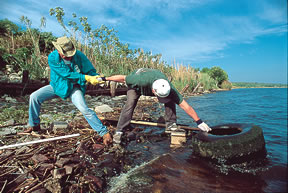
The St. Johns River Celebration is an annual event in which volunteers remove trash from the river and its tributaries. Begun by the district, the event has since been turned over to individual counties.
1996
The Water Management District Review Commission made 80 recommendations, and ultimately considered and approved a comprehensive legislative package. The water management districts were required to submit priority lists and schedules for the establishment of minimum flows and levels.
October 1995
The environmental resource and surface water permitting program of the St. Johns River Water Management District became effective as a result of a joint effort among all five water management districts and the DEP. Environmental resource permitting replaced the management and storage of surface waters, stormwater discharge, and wetland resource management permitting programs. Wetland delineations conducted under the program follow a unified, statewide methodology adopted in 1994.
1995
With a $60,000 grant from the U.S. Environmental Protection Agency, the St. Johns River Water Management District founded the Watershed Action Volunteer (WAV) Program. Within a year, the program included Duval, St. Johns, Clay, Flagler and Putnam counties. Its initial goal was to educate the public about water resource issues by giving them the opportunity to volunteer for community service projects that assisted local governments. These projects included measuring water quality, and helping to implement stormwater projects.
1995
The Legislature allowed the creation of a special fund for the proceeds of the Indian River Lagoon license plate, with 80 percent of the fund going toward lagoon restoration projects, shoreline stabilization and treatment of storm water. The remaining 20 percent goes toward public education projects about the lagoon.
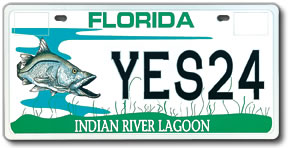
1995
The Florida Water Plan adopted by DEP states, “Water must be managed to meet the water needs of the people while maintaining, protecting and improving the state’s natural systems.”
August 1995
The St. Johns River Water Management District purchased development rights to property in Alachua and Volusia counties from Georgia-Pacific Corp., marking the first such arrangement in Florida.
1994
Environmental resource permitting consolidated.
1994
The water management districts completed comprehensive district water management plans.
1994
The St. Johns River Water Management District established the Orange Creek Basin Advisory Council to help develop a restoration and management plan for the basin.
1994
The Legislature also created the Water Management District Review Commission of 21 members appointed by the governor to submit a final report to the governor and the Legislature by Sept. 1, 1995.
1994
The Legislature amended Chapter 373,
Florida Statutes, to require water management districts to employ an inspector general (formerly chief internal auditor) to complete specified functions.
1993
Nease High School in St. Augustine approached the St. Johns River Water Management District for assistance in creating an environmental education academy. The district’s Stokes Landing property provided the perfect setting for applying environmental sciences in a living classroom. The property, a 274-acre tract of woods and marsh just five miles south of the school, became the birthplace of the Legacy Water Resource Education Program. The program grew into a cooperative educational venture between the district and area schools. It enlists educators and their students to help district staff make public lands more accessible.
1993
The Legislature passed the “streamlining bill,” which included the merger of the departments of Environmental Regulation (DER) and Natural Resources (DNR) into the Florida Department of Environmental Protection (DEP).
Other legislation required new water management district executive directors to be approved by the Senate; DEP to contract with the St. Johns River Water Management District to prepare environmental studies concerning the restoration or retention of Rodman Reservoir; the governor to appoint a land use and water planning task force; and new district budget review requirements. Also, a new wetland delineation rule defined wetlands by soils, vegetation and hydrology.
Amendments to Chapter 373,
Florida Statutes, in 1991 and 1993, required the submission of budget and program reports by each of the five water management districts to the governor’s office, both houses of the state Legislature and DEP. Both reports require explanations of program expenditures, revenue sources and preparation of capital improvement plans. The first report is required to be submitted in August after preparation of the tentative budget, and the second report is due in November after adoption of the final budget in September. This provides an opportunity for the state to comment on the budget proposals of each of the five water management districts.
1992
The St. Johns River Water Management District established a water use data management program to supply information needed for legislatively mandated water supply assessment, management and planning initiatives.
Aug. 24, 1992
Hurricane Andrew hit Florida, causing 23 deaths and $26.5 billion in damages. In response, the St. Johns River Water Management District initiated an emergency management program.
1992
The Legislature allowed the water management districts to use up to 15 percent of Save Our Rivers funds for land management and maintenance.
1991
U.S. Sen. Bob Graham (who is also a former Florida governor) visited the Lake Apopka North Shore Restoration Area in October 1991 to see the progress being made in the lake’s restoration. During his visit, Graham was shown the pea-green water from the lake and cleaner water that had been filtered through a demonstration marsh flow-way that the district had built on former farmland.
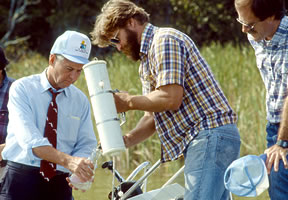
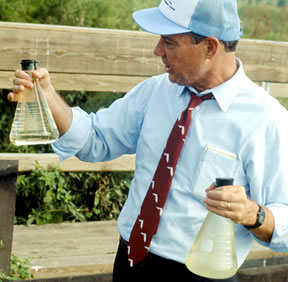
1991
The St. Johns River Water Management District began publishing StreamLines, the district’s free public newsletter. The publication was mailed to 7,500 subscribers, with publication slated for every other month.

1991
The St. Johns River Water Management District developed a minimum flows and levels (MFLs) method to protect water resources and ecology from “significantly harmful withdrawals” in the 400-square-mile Wekiva River Basin. The method can be used to determine MFLs for rivers, springs, lakes, wetlands and aquifers, and to assess consumptive uses of water in a cumulative and scientific manner. The district has since done more than 130 MFL determinations.
1991
Counties in Georgia and Florida formed the St. Marys River Management Committee to discuss improvements in the river.
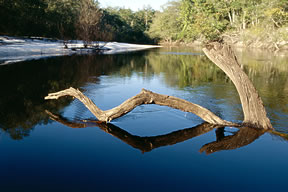
Views such as this along the St. Marys River are protected thanks to a partnership among a private St. Marys River Management Committee and the counties in Florida and Georgia that they work with, along with the district and various other agencies.
1991
The St. Johns River Water Management District’s radio telemetry network was expanded to include 97 stations linking the Upper St. Johns River Basin, the Indian River Lagoon, Lake Apopka and the Lower St. Johns River Basin to the district’s Palatka headquarters. Approximately 500 data collection devices, including meteorological gauges and water level recorders, were part of that network.
1991
The Legislature changed the SWIM funding ratio from 80 percent state/20 percent water management district to 60 percent state/40 percent water management district.
1991
The St. Johns River Water Management District issued the districtwide Water Conservation Rule — the first of its kind in the state. The year-round rule allowed outdoor irrigation before 10 a.m. and after 4 p.m. daily throughout the district’s service area.
1991
The Indian River Lagoon became part of the National Estuary Program. It had been nominated by the St. Johns River Water Management District, the state of Florida and the nonprofit Marine Resources Council of east central Florida.
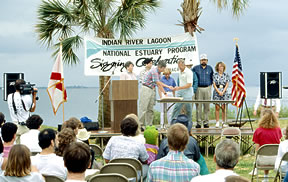
State, local and federal dignitaries gathered for a ceremony marking the Indian River Lagoon as a part of the National Estuary Program.
1990
The St. Johns River Water Management District purchased the 6,330-acre Jennings State Forest in Clay County through the Preservation 2000 program, making it the first P-2000 purchase in Florida.
1990
The Central Florida Beltway Mitigation Act was adopted to offset adverse environmental impacts from construction of the beltway.
1990
The Legislature enacted the Florida Preservation 2000 Accelerated Land Acquisition program. $300 million a year was provided over 10 years to purchase ecologically valuable lands.
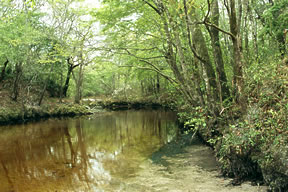
Public ownership of properties such as this one preserves “natural” Florida and its water resources for future generations.
1990
Construction began at the district’s Palatka headquarters for a new executive building, which houses a large meeting room to accommodate meetings of the Governing Board.



The district’s list of responsibilities had grown to the point that additional staff accommodations were needed in 1990. Here, construction begins and the simple landscaping when the building was completed is shown. The third photo is of the building’s entrance as it now appears with water-efficient, Florida-friendly landscaping.
1990
Florida’s population reached 12.9 million.
1990
The Legislature required elimination of existing discharges of treated effluent into the Indian River Lagoon before July 1, 1995.
1990
The Commission on the Future of Florida’s Environment submitted its conclusion, stating that the most far-reaching means of protecting the face of Florida is to acquire large amounts of land. “Acquisition coupled with restoration and regulation will best serve Florida’s major ecological systems,” the report says.
1989
The St. Johns River Water Management District founded the Geographic Information Systems Development program.
August 1989
The St. Johns River Water Management District declared a Phase I Moderate Water Shortage for all 19 counties within the district, replacing an initial water shortage warning issued the previous June. The Phase I Water Shortage included both mandatory and voluntary restrictions for ground and surface water use. Insufficient rainfall, low monitor-well levels and increased usage were key factors in the district’s decision. New record-low levels were recorded at many monitoring wells throughout the district, with others approaching near-record lows.
1989
The St. Johns River Water Management District opened its present laboratory building at its Palatka headquarters. The 6,000-square-foot building housed 13 scientists, and averaged about 120,000 analyses per year.
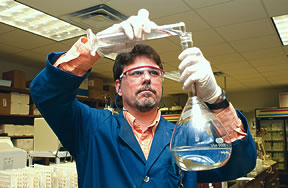
A growing list of responsibilities necessitated the expansion of the district’s laboratory facilities, where scientists performed about 120,000 analyses each year.
1988-1990
The Legislature conducted a sunset/sundown review of the water management district system of water resource management and re-enacted Chapter 373,
Florida Statutes, and provided the water management districts with new provisions of financial and program performance accountability.
1988
The Environmental Efficiency Study Commission submitted its final report with findings and recommendations. Gov. Bob Martinez created the Commission on the Future of Florida’s Environment, appointing 29 members. The governor named Nat Reed as chairman and Jim Swann as vice chairman, and directed that the commission report and be terminated in 1990.
May 9, 1988
The Upper St. Johns River Basin Project as we know it today officially began at a groundbreaking in Fellsmere. It marked the beginning of the process to restore more than 150,000 acres of the headwaters of the St. Johns River that had been drained. This was a dramatic shift in the region’s prior flood control policy, moving toward a more natural, non-structural approach.
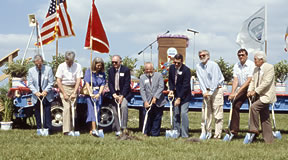
District Governing Board members turn the dirt at a groundbreaking ceremony at the Upper St. Johns River Basin Project in May 1988.
1988
With funding from the SWIM program, the St. Johns River Water Management District began restoration of the Upper Ocklawaha River Basin and the Lower St. Johns River Basin.
Jan. 4, 1988
The Florida Department of Environmental Regulation delegated authority to permit dredging and filling of wetlands to the St. Johns River Water Management District. The district was the first in the state to receive such authority.
1987
The federal Clean Water Act amendments established the National Estuary Program.
1987
The Surface Water Improvement and Management (SWIM) Act recognized Lake Apopka, the Lower St. Johns River Basin and the Indian River Lagoon as areas in need of special protection and restoration.
December 1986
The Legislature enacted the Surface Water Improvement and Management (SWIM) Act to preserve and restore surface water quality on priority waters.

December 1986
The St. Johns River Water Management District made its first land purchase through the Conservation and Recreation Lands (CARL) program. It was the joint purchase with the state of Florida of the 2,349-acre Canaveral Industrial Park in Brevard County.
1986
“A major challenge for the district Governing Board has been to provide effective management of our ground and surface waters while not placing an undue financial burden on the taxpayers,” said St. Johns River Water Management District Governing Board Chairman Ralph E. Simmons in the district’s 1986–1987 Annual Report. “We are proud of what the district has been able to accomplish but realize our journey is far from over. We hope all district citizens and taxpayers who comprise our shareholders will join us to help chart the course. Our future depends on it.”
“The business of water management is a continuous and ongoing responsibility,” said District Executive Director Henry Dean in the report. “We remain committed to doing all that is necessary to safeguard and enhance our bountiful water resources.”
1986
The Florida Legislature established the nation’s first program to clean up contamination from leaking underground petroleum storage tanks.
October 1986
The St. Johns River Water Management District opened its Jacksonville Service Center in its present location in Baymeadows.
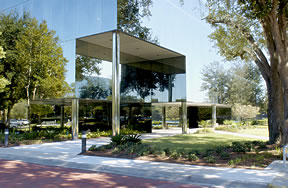
The district’s Jacksonville Service Center is housed in an office complex in the Baymeadows area of the north Florida city.
1986
A two-year, 15-member Environmental Efficiency Study Commission was established, with Jay Landers as chairman and David Gluckman as vice chairman.
April 1986
Water management districts that had been delegated stormwater regulation responsibilities were directed to adopt a rule establishing permit criteria for the regulation of isolated wetlands, including the protection of threatened and endangered species.
Dec. 16, 1985
The St. Johns River Water Management District opened an Orlando office on East South Street, five blocks south of Lake Eola Park.
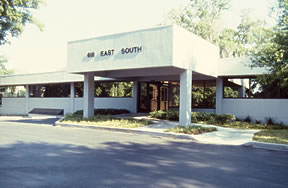
The district’s offices in east-central Florida were originally housed in this facility on East South Street in Orlando.
1985
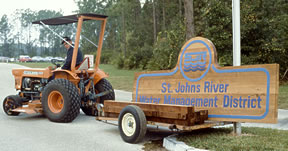
A sign is moved into place to designate the entrance of the St. Johns River Water Management District’s headquarters in Palatka in 1985.
1985
The restoration of Lake Apopka and the Harris Chain of Lakes began with the Lake Apopka Restoration Act.
Oct. 10, 1984
Henry Dean was named executive director of the St. Johns River Water Management District.

Henry Dean
1984
The Legislature enacted the Warren S. Henderson Wetlands Protection Act.
1984
The original building that housed the offices of the St. Johns River Water Management District has undergone many changes over the years. This is the Administration Building as it appeared in 1984.
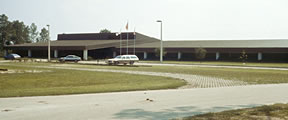
1984
The water well construction permitting and contractor-licensing program was delegated to the St. Johns River Water Management District by the Florida Department of Environmental Protection.
Dec. 7, 1983
The St. Johns River Water Management District received authority to issue Management and Storage of Surface Water permits districtwide. It had previously issued these permits only in the Ocklawaha River Basin and the Upper St. Johns River Basin. The new authority expanded its ability to regulate and control stormwater discharges from development.
1983
The St. Johns River Water Management District began its abandoned artesian well plugging program.
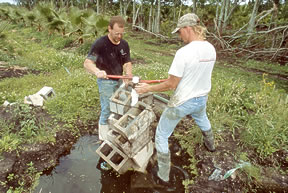
Plugging abandoned, free-flowing artesian wells helps to save water.
1983
The Florida Water Quality Assurance Act established a statewide surface and groundwater monitoring network. Gov. Bob Graham praised it as “one of the most outstanding pieces of legislation of the 1983 legislative session.”
Jan. 1, 1983
The St. Johns River Water Management District began permitting consumptive uses of water districtwide. Permitting allowed the district to better monitor developmental trends in its service area.
1982
The constitutionality of water management district taxing powers is affirmed by the Florida Supreme Court.
1982
The St. Johns River Water Management District purchased the 33,650-acre Seminole Ranch Conservation Area through the Save Our Rivers Program (SOR), making it the first SOR purchase in Florida.
1982
The Florida Department of Environmental Regulation was empowered to set up rules establishing “Outstanding Florida Waters” designations.
Oct. 1, 1982
The St. Johns River Water Management District opened an office in the city of Mount Dora, less than 10 miles from the district’s present Lake Apopka field office. The rent was $350 per month, and the building included a fireplace and a woodstove.
May 14, 1982
Relieved by reports that water resources throughout most of the district had recovered to near normal conditions, the St. Johns River Water Management District discontinues its emergency Water Shortage Declaration. Recovery came in the opposite extreme, with heavy flooding in some areas from up to 12 inches of rainfall in a 24-hour period — a storm severity greater than 1-in-100-year frequency. By September 1982, storms had dumped as much as 81 inches in DeLand and Ocala — 28 inches more than normal.
May 1981
The St. Johns River Water Management District released an emergency Water Shortage Declaration. The record-breaking rainfall deficit that began in 1980 ranged from 12 inches to 22 inches throughout the 19-county district and reached a drought severity of 1-in-200-year frequency.
1981
“During the past year, our hope has been that we have achieved a new level of professionalism, growth and maturity as an agency and made significant strides in accomplishing our long-term goals relating to the Upper St. Johns Project and districtwide implementation of our regulatory programs,” said St. Johns River Water Management District Governing Board Chairman Frances Pignone in the district’s Annual Report. “We eagerly anticipate the opportunity to continue progress made in land acquisition for non-structural water management, completion of a water shortage plan and the exciting work to be accomplished in developing groundwater basin inventories. We are gratified for the support we have received from so many interested individuals and groups in the past and urge your participation with us in meeting future water management challenges.”
1981
The Legislature granted authority and provided funding for the acquisition and management of water management lands (commonly known as Save our Rivers).
1980
Sonny Vergara was named executive director of the St. Johns River Water Management District.
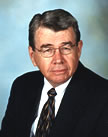
Sonny Vergara
1980
Floridan aquifer levels in the Fort Walton Beach area had declined as much as 100 feet below sea level.
Nov. 11, 1980
The St. Johns River Water Management District opened its new headquarters building, the present-day Administration Building, on land donated by the city of Palatka. Staff formerly worked in a warehouse and trailers on State Road 19 and in offices in downtown Palatka. The building is dedicated to R. Tommy Clay, a Governing Board chairman who was instrumental in establishing the headquarters in Palatka.
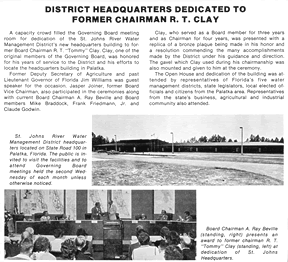
A newspaper clipping from late 1980 marked the dedication of the district’s Administration Building to former Board Chairman Tommy Clay.
June 27, 1979
The district’s Governing Board signed a contract for $1.25 million to construct a permanent building on land donated to the district by the city of Palatka on U.S. Highway 100 West. The building would later be known as the Administration Building.

Participants in the contract signing to build the Administration Building were, from left, Cliff Townsend (a Board member and chair of the building committee), B.E. McCall (president of R.W. Roberts Construction Co.), Tommy Clay (Board chairman), E.L. Walker (Palatka mayor), and Jack Rood (an architect with Stottler, Stagg and Associates).
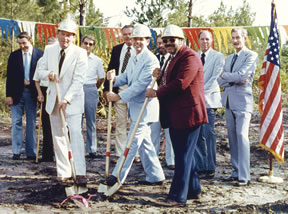
After about eight years in existence, the St. Johns River Water Management District established permanent headquarters facilities in Palatka, building what is now referred to as the Administration Building. Over the years, further construction occurred at the Palatka facility as the district’s responsibilities and staff grew. Governing Board members and local dignitaries participated in a groundbreaking ceremony.
Oct. 18-20, 1978
The St. Johns River Water Management District’s Governing Board spent three days sailing the St. Johns River, from Blue Cypress Lake, in Indian River County, to the Ortega River in Jacksonville. Governing Board members reported significant signs that floodplain management was needed to protect residents, boaters and the river.
1978
The St. Johns River Water Management District started its laboratory services and surveying services programs. The lab was a small room at the end of a trailer. The only lab technician kept records in boxes filled with index cards and sheets of paper. He averaged about 3,000 analyses per year.
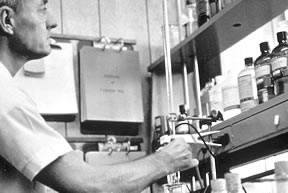
The district’s first laboratory facility was small and antiquated by today’s standards.
1977
The South Florida Water Management District transferred 92,750 acres in the headwaters of the St. Johns River to the St. Johns River Water Management District, commencing the Upper St. Johns River Basin Project.
1977
The St. Johns River Water Management District published its first annual report, seeing “the need to communicate to the citizens the activities of the district.”
“This past year of 1977 was the most active and successful for the new SJRWMD,” said District Governing Board Chairman Tommy Clay in the report. “A districtwide water use plan, mandated by the Legislature, was adopted outlining the Board philosophy and plans for long-term water use. Several years of extensive research and planning ended in a timetable for work to begin on the long-delayed Upper St. Johns River Project.”
Executive Director Frederick O. Rouse agreed, calling 1977 “a most productive period for the district.” He went on to say that “the overall objective of water management is to make the most efficient use of water possible, to make sure that water is available to everyone who needs it in the amount and quality they need — not just now, but in the future too. The administrative system is receiving a crucial test in Florida. Florida has one of the most advanced water management systems in the country.”
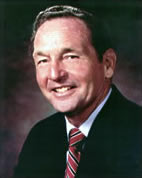
R.T. “Tommy” Clay
Feb. 28, 1977
Frederick Rouse was hired as executive director of the St. Johns River Water Management District.
Rouse had four directors with professional staffs. Mildred Horton, director of administration, was administrator for purchasing, finance and accounting, and the Division of Real Estate and Surveying. Jerry Kubal, director of water resources, was responsible for engineering, resource evaluation, water resource research, and technical coordination and geotechnical functions. George Griffith, director of resource planning and management, oversaw the district’s water resources plan, permitting and enforcement, and internal planning. Michael Young, director of environmental sciences, had responsibility for all district environmental programs.
Jan. 1, 1977
The St. Johns River Water Management District assumed responsibility for the Moss Bluff Lock and Dam, the Burrell Lock and Dam, and the Apopka-Beauclair Lock and Dam. The facilities were transferred from the Southwest Florida Water Management District along with responsibilities for the Ocklawaha River Basin.
1976
Residency requirements were created for district governing board members, and the six water management districts were reduced to five. The St. Johns River Water Management District service area expanded to include the Upper St. Johns River Basin and the Ocklawaha River Basin. Local governments were pre-empted from regulating consumptive uses of water. The Legislature created the West Coast Regional Water Supply Authority.
March 9, 1976
A voter-approved, Florida constitutional amendment authorized water management districts to levy ad valorem taxes up to 1 mill, but the Northwest Florida Water Management District was capped at 0.05 mill.
1975
The Legislature passed the Environmental Reorganization Act, delegating authority to the water management districts and creating the Department of Environmental Regulation. It also moved the general supervisory oversight of water management districts from the Department of Natural Resources to the new Department of Environmental Regulation. The Central and Southern Florida Flood Control District and the Ridge and Lower Gulf Coast Water Management District were combined to form the South Florida Water Management District, reducing the original six water management districts to five.
1975
The St. Johns River Water Management District acquired a Prime 300 computer. The machine had two terminals, was about six feet tall and three feet wide, and had roughly eight megabytes of memory. It was used for scientific modeling, processing payroll and maintaining mail lists.
Feb. 21, 1974
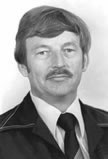
Dennis Auth:
The St. Johns District’s first executive director.
The St. Johns River Water Management District held its first Governing Board meeting. The Governing Board members were Tommy Clay, a Putnam County cattle rancher; Bobby White, a St. Johns County farmer; Francis (Jim) Knapp, chairman of the Department of Biology at Stetson University; Jim Terrell, a Duval County attorney; John Krider of Seminole County; John Dicks, of Feed and Seed Company in Duval County; Tommy Shave of Nassau County; Suzanne Bayley, professor of engineering sciences at the University of Florida; and Art Marshall,a Putnam County environmentalist and the district’s first Governing Board chairman.
At the first meeting, in Daytona Beach, Dennis Auth was hired as the district’s first executive director. At the second meeting, in Sanford, Palatka was determined as the headquarters site for the district. Including Auth, the district had five employees by the end of the year.
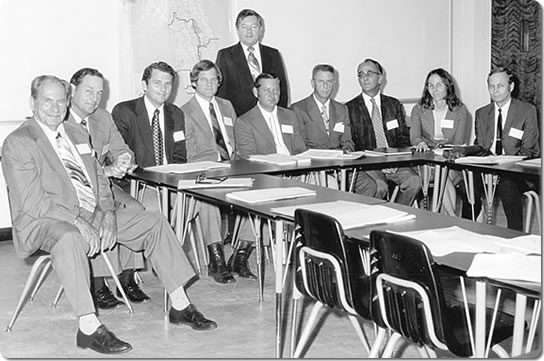
Shortly after being appointed by the Florida Governor to the Governing Board of the St. Johns River Water Management District, board appointees met for an organizational meeting.
1973
Governing Board members were appointed to water management districts statewide.
1973
Big Cypress Swamp was designated as an area of critical state concern.
1973
The Legislature appropriated funds for the Special Project to Prevent Eutrophication of Lake Okeechobee.
1972
In what’s often called “the year of the environment,” several natural resource bills were passed.
- The Florida Water Resources Act created six regional water management districts and established a permit system for allocating water use. Those six districts became the current five in 1975 when two were combined to form the South Florida Water Management District. The legislation became law when signed by Gov. Reubin Askew on April 8, 1972.
- The Land Conservation Act authorized the sale of state bonds to purchase environmentally endangered lands, and Florida voters approved a constitutional amendment authorizing $240 million in state bonds for the Department of Natural Resources to purchase environmentally endangered lands.
- The Environmental Land and Water Management Act created the Development of Regional Impact and Areas of Critical State Concern programs.
- The Comprehensive Planning Act required development of a state comprehensive plan.
- The federal Clean Water Act set “swimmable and fishable” as the goal for all U.S. waters.
Sept. 22, 1971
State and local leaders met in Miami for the first Conference on Water Management.
1971
Construction of the Cross-Florida Barge Canal was halted.
1970
Florida’s population reached 6.79 million.


